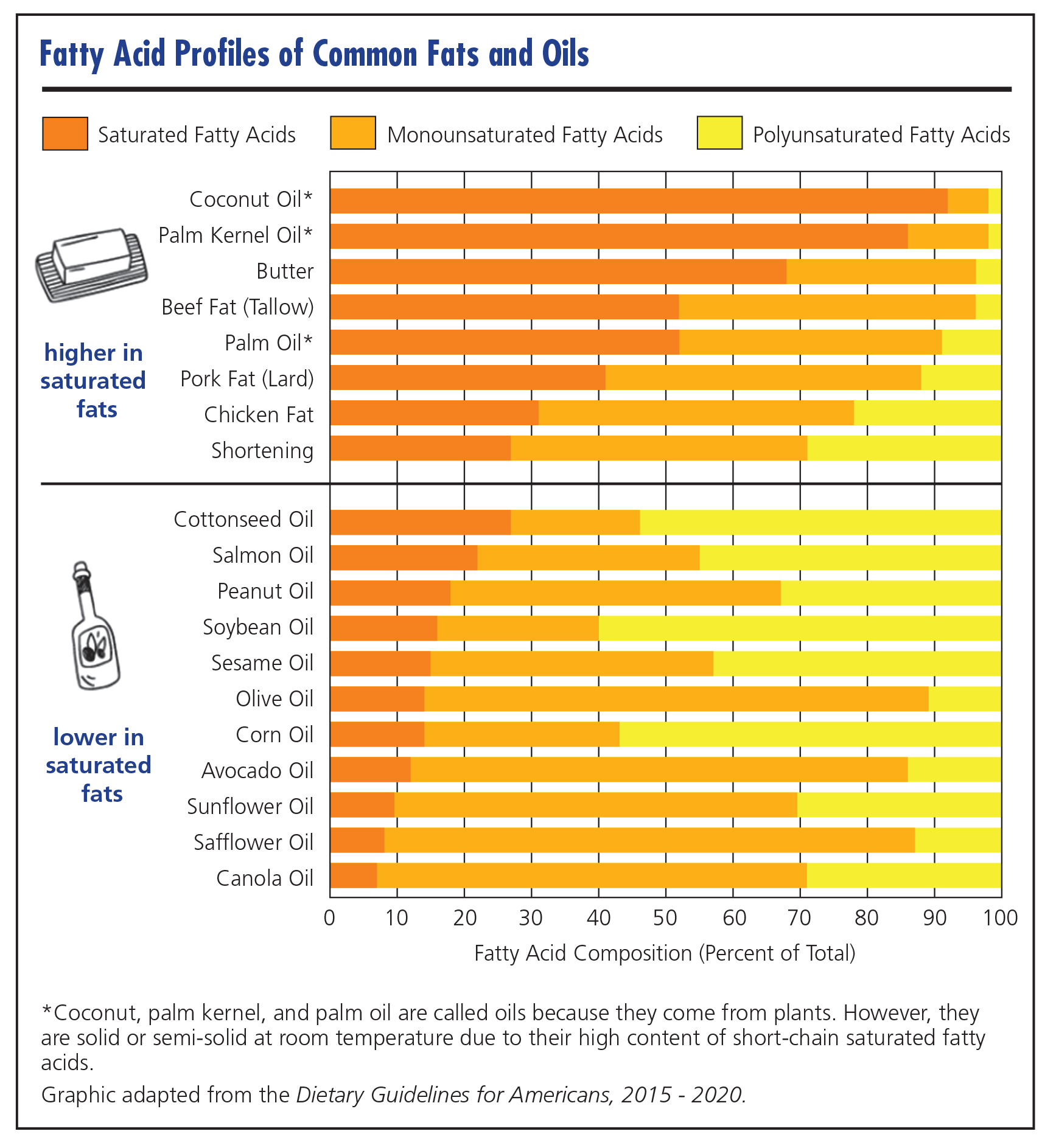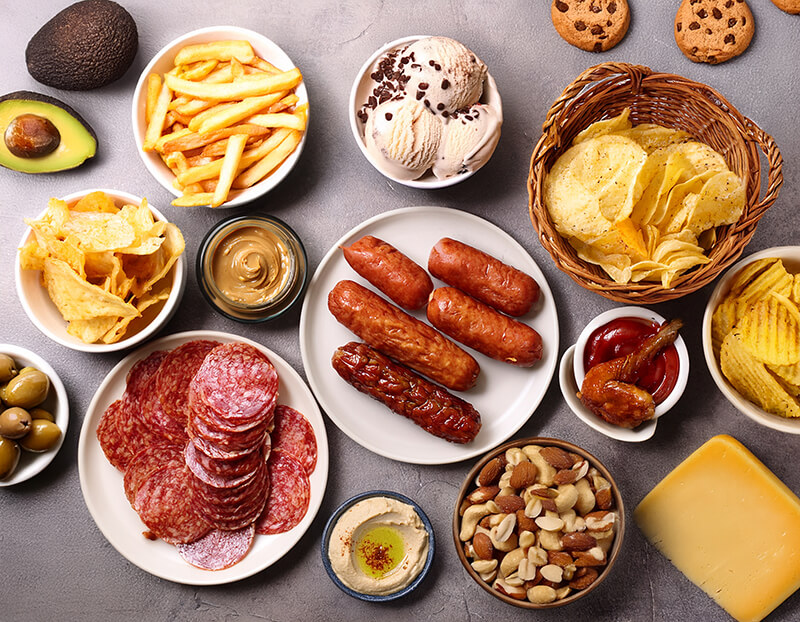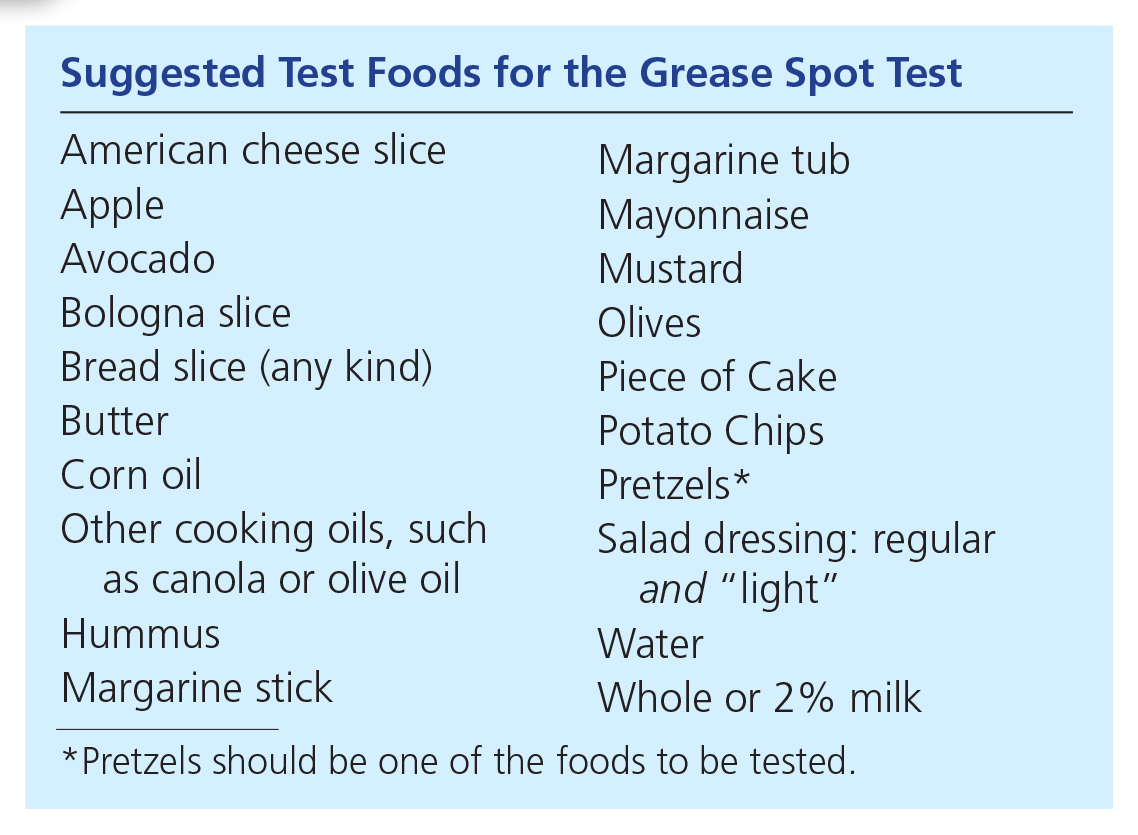Lipids are a large group of organic compounds that are oily to the touch and insoluble in water. Lipids include fats, oils, and waxes and are a source of stored energy. The terms lipids and fats are often used interchangeably. Fats are also called triglycerides, because they are usually made up of three fatty acids and a glycerol molecule. For this module, we will use the term “fat” to represent all dietary lipids. Oils are usually liquid at room temperature, high in monounsaturated or polyunsaturated fatty acids, and lower in saturated fatty acids than fats that are solid at room temperature.
Understanding Dietary Fat
Dietary fats are found in both plant and animal foods, and they are broken down into fatty acids during digestion. All dietary fats are composed of a mix of saturated, monounsaturated, and polyunsaturated fatty acids, in varied proportions. For example, most of the fatty acids in butter are saturated, but it also contains some monounsaturated and polyunsaturated fatty acids. Fat is also a source of essential fatty acids (linoleic acid and alpha-linolenic acid), which the body cannot synthesize (produce) and therefore must obtain from the diet.
Fat in foods is a major source of energy for the body and aids in the absorption of the fat-soluble vitamins A, D, E, and K. Fats are also important for proper growth and maintenance of good health, since they play a role in the structure and function of cell membranes, the integrity of skin, maintaining healthy blood cells, and fertility. As a food ingredient, fats provide taste, consistency, and stability and help us feel full.
The Daily Value for total fat is 35% of total calories, which is 78 grams/day based on a 2,000-calorie diet: saturated fats should contribute less than 10% of daily calories. All fat has 9 calories per gram, making it a concentrated source of energy, so it should be eaten in moderation. Although most people consume enough fat, many people consume too much saturated fat and not enough unsaturated fat. The Nutrition Facts label is a useful tool for checking how much, and what kind of fat is in a food. 
About Saturated Fatty Acids
Saturated fats are typically found in animal products. Dietary fats that have more saturated fatty acids tend to be solid at room temperature. They are called “saturated” because all the spaces on the fat molecule that can hold a hydrogen atom do so and are “full” – that is, the molecule is “saturated” with hydrogen atoms.
Saturated fats taste good and reduce hunger, but eating too much of them increases the risk of cardiovascular disease. Saturated fatty acids are found in the greatest amounts in animal fats (including beef, pork, lamb, and poultry with skin), full-fat dairy products (butter, cream, cheese, and ice cream), many sweet desserts (cakes and cookies), fried foods, and some plant-based oils such as coconut oil, palm oil, and palm kernel oil.
About Unsaturated Fatty Acids – Heart Healthy Fats!
Unsaturated fatty acids include monounsaturated and polyunsaturated fatty acids. They are called “unsaturated” because some of the carbon atoms in the fat molecule do not hold a hydrogen atom. They are found in higher proportions in plants and seafood.
Monounsaturated fatty acids have one double bond in the fat molecule, and polyunsaturated fatty acids have more than one double bond. Oils that are high in unsaturated fatty acids are not considered to be a separate food group, but they are important because they can reduce the risk of developing cardiovascular disease when eaten in place of saturated fat.
- Monounsaturated fatty acids (MUFAs) are found in relatively large amounts in olive, canola, saffower, and sunfower oils as well as in avocados, peanut butter, and most nuts. There is no recommended daily intake of MUFAs.
- Polyunsaturated fatty acids (PUFAs) are found in vegetable oils and fatty fish such as salmon, mackerel, and sardines. PUFAs include omega-3 and omega-6 fatty acids, which are the two primary types of essential fatty acids (EFAs). EFAs are nutrients required for normal body functioning, but they cannot be made by the body and must be obtained from food. The body uses this fat to build cell membranes and nerve tissue (including the brain), and to regulate hormones.
Reducing Saturated Fats
Unsaturated fats and oils should replace saturated fats in the diet, rather than just being added to it. This allows the total amount of fat consumed to remain within recommendations without exceeding daily calorie limits. While unsaturated fatty acids are an optional listing on Nutrition Facts labels, they are included in the Total Fat category. One gram of unsaturated fat is healthier than one gram of saturated fat, but both have the same number of calories: 9 calories per gram.
About Trans Fats, A Danger Zone!
Trans fat is an unhealthy fat. Although trans fatty acids are unsaturated, they are structurally similar to saturated fatty acids and therefore behave like them. Trans fat raises LDL (“bad” cholesterol), and an elevated LDL increases the risk of developing cardiovascular disease (see the Cholesterol section below).
The National Academies of Science, Engineering, and Medicine recommends that trans fat consumption be as low as possible without compromising the nutritional adequacy of the diet. As of June 2018, partially hydrogenated oils (PHOs), the major source of artifcial trans fat in the food supply, are no longer Generally Recognized as Safe (GRAS). Therefore, PHOs are no longer added to foods. But trans fat will not be completely gone from foods because it occurs naturally in small amounts in some animal products and is present at very low levels in refined vegetable oils. This hidden fat can add up if you eat several servings of products that contain it. Learn more about trans fat at this FDA webpage.
About Cholesterol
Cholesterol is a waxy, fat-like substance made by all cells of the body. The organs that make the most cholesterol are the liver and intestines. The body uses cholesterol to produce vitamin D and certain hormones (e.g., estrogen and testosterone) and bile (a fuid that aids in fat digestion). Cholesterol in food is referred to as “dietary cholesterol” and is found only in animal products—never in plants. Cholesterol is transported in the blood by particles called “lipoproteins,” which contain both fat and protein. Over time, cholesterol and other substances can build up in the arteries and cause cardiovascular problems. The human body makes all the cholesterol that it needs, so it is not necessary to get cholesterol from food.
HDL & LDL Cholesterol
High Density Lipoprotein (HDL) cholesterol is often referred to as “good” cholesterol. HDL cholesterol travels from the body tissues to the liver, where it is broken down and removed. Higher levels of HDL cholesterol in the blood can help prevent cholesterol buildup in blood vessels, decreasing the risk of developing cardiovascular disease.
Low-density Lipoprotein (LDL) cholesterol is often referred to as “bad” cholesterol. It is the form that moves cholesterol from the liver to the arteries and body tissues. Higher levels of LDL in the blood can lead to a harmful cholesterol buildup in blood vessels, increasing the risk of cardiovascular disease.
Foods such as meats and dairy products that are high in saturated fats may also be sources of dietary cholesterol. This combination can increase the risk of developing cardiovascular disease. The goal for consumption is to get less than 100% of the Daily Value for saturated fat and cholesterol each day: limiting intake of saturated fats will also help to limit intakes of dietary cholesterol.
More About Cholesterol
Saturated fat and trans fat intake affect the level of cholesterol in blood more than consumption of dietary cholesterol does; therefore saturated and trans fats are more important dietary risk factors for coronary heart disease than is dietary cholesterol. It’s more important to limit saturated fat and trans fat in the diet than it is to limit dietary cholesterol.
- Foods that are high in cholesterol also are often high in saturated fat, so by limiting the consumption of saturated fat from animal sources, one can usually also reduce cholesterol intake.
- FDA considers the amount of dietary cholesterol in foods to be important information for consumers to know.
- The Dietary Guidelines for Americans, 2020-2025, address dietary cholesterol with the following statement: “The National Academies recommends that trans fat and dietary cholesterol consumption to be as low as possible without compromising the nutritional adequacy of the diet. The USDA Dietary Patterns are limited in trans fats and low in dietary cholesterol. Cholesterol and a small amount of trans fat occur naturally in some animal source foods.”

 Six test foods from the Suggested Test Foods list. Each team should have one sample of each food.
Six test foods from the Suggested Test Foods list. Each team should have one sample of each food.

